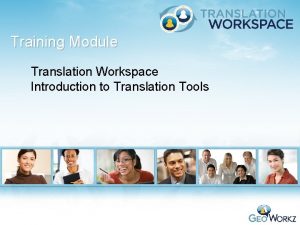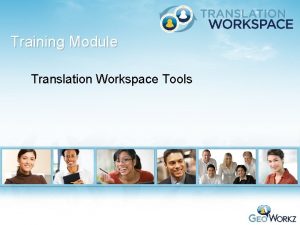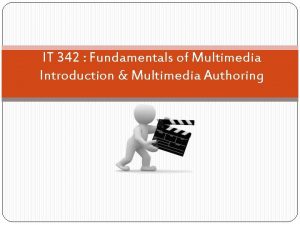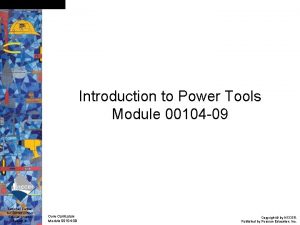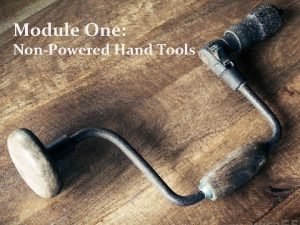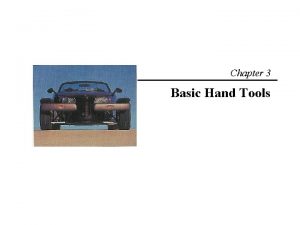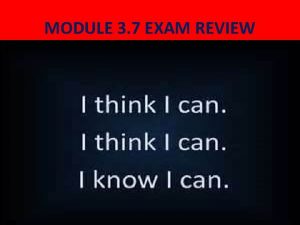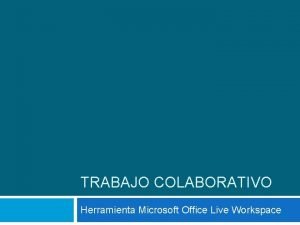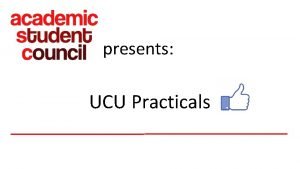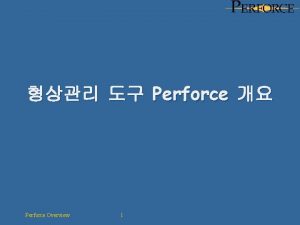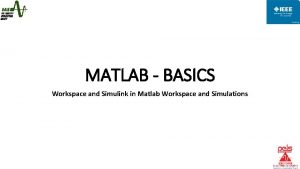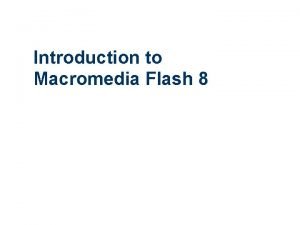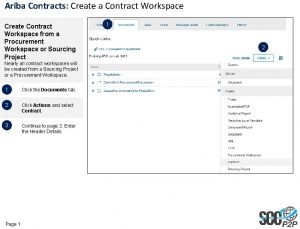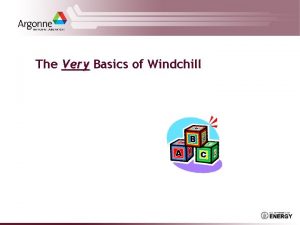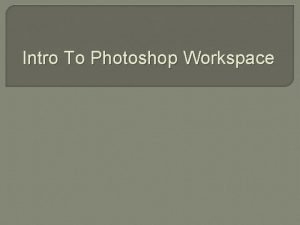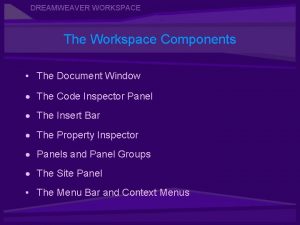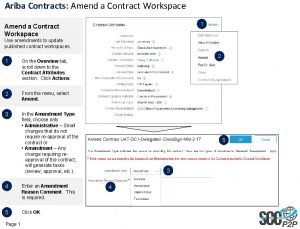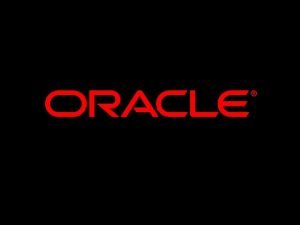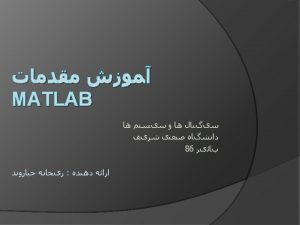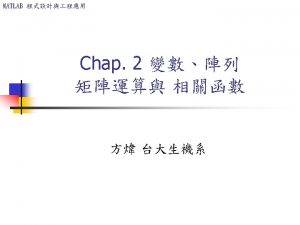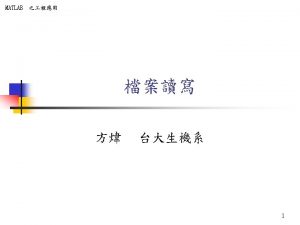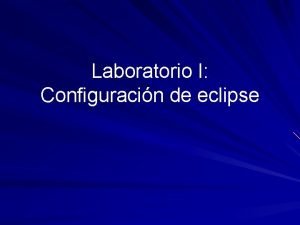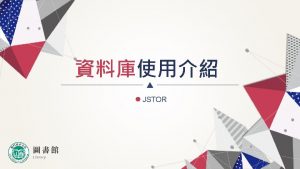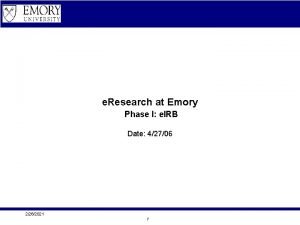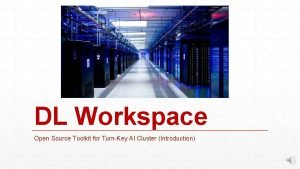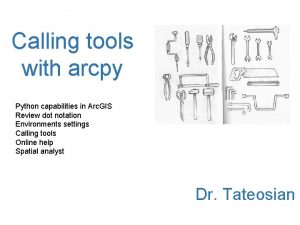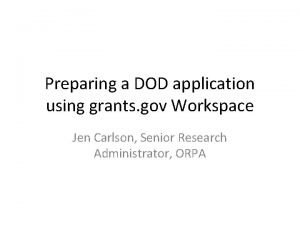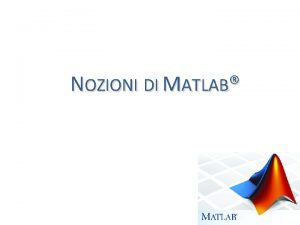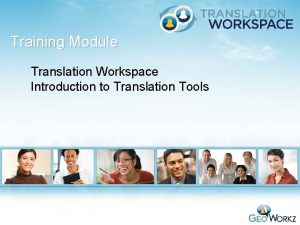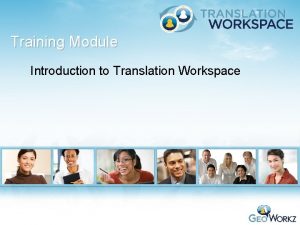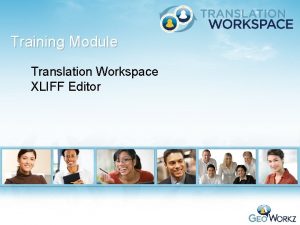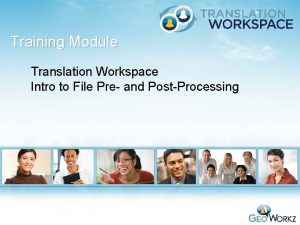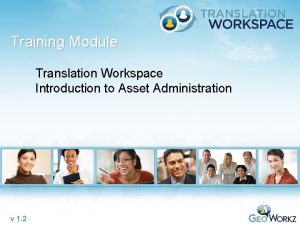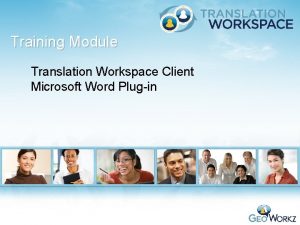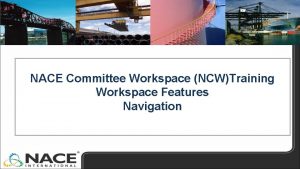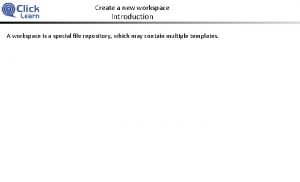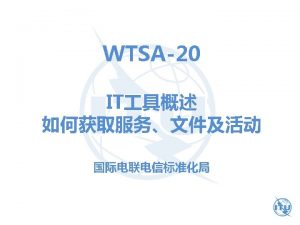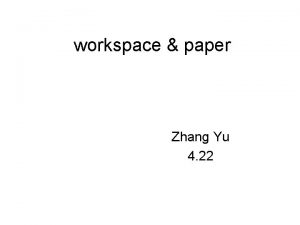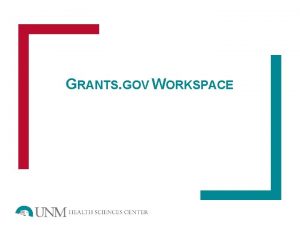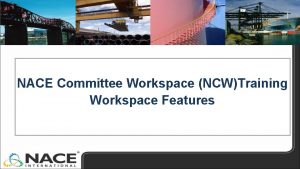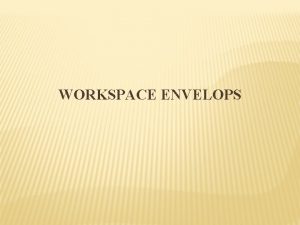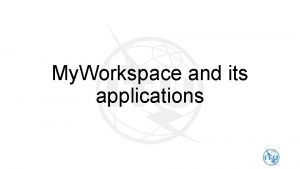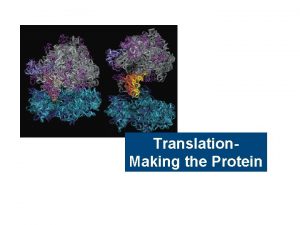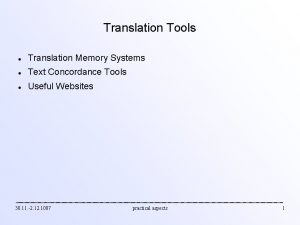Training Module Translation Workspace Tools Training Module Overview






































- Slides: 38

Training Module Translation Workspace Tools

Training Module Overview Course Objective: This course provides detailed instruction on how you can utilize Translation Workspace Tools in different stages of a localization project. Upon course completion, you are comfortable with the basic uses of Translation Workspace Tools. Duration: 90 minutes Prerequisites: • • • Intro to Administration TM Management Glossary Management Intro to Pre/Post Processing Word Client Suggested Subsequent Training: • • 2 Asset Aliasing File Filters Copyright 2010 Geo. Workz

Learning Agenda 1. Introduction to Translation Workspace Tools 2. Translation Workspace Tools Interface 3. Localization Process 4. Localization Pre-Processing 5. Localization Post-Processing 6. Other Functions • Translation Memory Management • Attribute Management Copyright 2010 Geo. Workz

Introduction to Translation Workspace Tools Overview of the Localization process Translation Workspace tools can be used throughout the life cycle of a Localization project Pre-Processing Conversion Segmentation Analysis Translate Edit Proofread Language QA Review TM update Clean to Target Pre-Translation Post-Processing • 4 File Conversion Translation Memories & Glossaries • To mention a few functions, the tools can be used to Edit or Import/Export project TMs, convert and prepare files for translation, analyze the prepared files against project TMs, clean bilingual files, and run Quality Assurance tasks Copyright 2010 Geo. Workz

Introduction to Translation Workspace Tools vs Clients • Many of the functions performed by Translation Workspace Tools can also be performed using the Microsoft Word Plug-in or the XLIFF Editor • Translation Workspace Tools are more useful for performing batch processes such as analyzing a batch of files or converting a batch of files from one format to another • Another benefit of using Translation Workspace Tools is that it leaves the Microsoft Word Plug-in or XLIFF Editor free for other tasks 5 Copyright 2010 Geo. Workz

Introduction to Translation Workspace Tools Installing and Accessing the Tools • Translation Workspace Tools are part of the Translation Workspace Client installation package • Within the installation package, you can choose whether to install the Translation Workspace Tools or not • Once installed, Translation Workspace Tools are accessible in the Windows Programs list or via Windows Explorer You do not need Microsoft Word to access the Translation Workspace Tools For more information on the installation process, refer to the “Translation Workspace Clients – Microsoft Word Plug-in” training. 6 Copyright 2010 Geo. Workz

Learning Agenda 1. Introduction to Translation Workspace Tools 2. Translation Workspace Tools Interface 3. Localization Process 4. Localization Pre-Processing 5. Localization Post-Processing 6. Other Functions • Translation Memory Management • Attribute Management Copyright 2010 Geo. Workz

Translation Workspace Tools Interface Menu Options File Menu In the Translation Workspace Tools window, click File > Exit, to exit the window View Menu Click View > Status Bar to show/hide the Status bar. In the View menu you can choose the Icons, List, or Details option to view the various functions or tools as icons, as a list or as a list with brief descriptions. 8 Copyright 2010 Geo. Workz

Translation Workspace Tools Interface Menu Options Settings Menu Click Settings > Single Sign-On to enable the single sign-on option. This option enables you to use all Workspace Tools modules without having to re-login each time you start using another module. To close the existing connection to Translation Workspace, click Settings > Close Connection to Translation Workspace. To change the current selection of TM, click Settings > Select TM. 9 Copyright 2010 Geo. Workz

Translation Workspace Tools Interface Menu Options Help Menu The Help Menu enables you to view the current version of Translation Workspace Tools that you are using. You can also access the Translation Workspace Tools Online Help here. 10 Copyright 2010 Geo. Workz

Learning Agenda 1. Introduction to Translation Workspace Tools 2. Translation Workspace Tools Interface 3. Localization Process 4. Localization Pre-Processing 5. Localization Post-Processing 6. Other Functions • Translation Memory Management • Attribute Management Copyright 2010 Geo. Workz

Localization Process Overview • Common tasks performed prior to translation of a document: • File preparation, conversion, analysis • Common tasks performed after translation of a document: • Quality Assurance (QA) checks, back conversion For example, here is the process for preparing a DOCX file for translation: 1. Convert the DOCX file into a Translation Workspace RTF/XLIFF using the Conversion Tasks >Convert (DOCX Filter) tool. 2. Choose the appropriate TM to analyze the file using the Analyze function. And the process after translation: 1. Run QA Tools for the translated files to ensure back convertibility. 2. Then use the Conversion Tasks > Back Convert tool to convert the RTF/XLIFF file back to DOCX format. Now you have a RTF/XLIFF file prepared for translation, and a wordcount analysis log. For more information on file processing tasks, refer to the “Intro to File Pre- and Post-processing” training. 12 Copyright 2010 Geo. Workz

Learning Agenda 1. Introduction to Translation Workspace Tools 2. Translation Workspace Tools Interface 3. Localization Process 4. Localization Pre-Processing 5. Localization Post-Processing 6. Other Functions • Translation Memory Management • Attribute Management Copyright 2010 Geo. Workz

Localization Pre-processing File Preparation and Conversion • During file preparation, the Source document that needs to be translated is converted into a format (the pivot format) that can be processed using the Translation Workspace clients and TMs. • For preparing file formats such as XML, HTML, SGML, INX, TTX, DOCX, PPTX, MIF, and XLSX for translation, use the Convert tool to convert these files to RTF or XLIFF format which can then be processed in the Translation Workspace clients. For tagged file formats, we recommend using the XLIFF Editor for translating 14 Copyright 2010 Geo. Workz

Localization Pre-processing Document Conversion Dialog • The Document Conversion Tool allows you to convert (“tag”) all structural elements of several tag file formats (MIF, INX, DOCX, PPTX, XLSX, and markup language files like HTML, XML, and SGML) into specially formatted, protected text, and leave all translatable content editable. • You can then translate the “tagged” file, and after translation convert it back to the original file format. You can use this dialog also to convert TTX files to RTF or XLZ. 15 Copyright 2010 Geo. Workz

Localization Pre-processing Document Conversion Dialog • Open the Document Conversion dialog by double-clicking Conversion Tasks > Convert. • Drag the files or folders containing the files you need to convert on the dialog box. The tool checks if the selected documents are of the correct type (HTML, XML, SGML, XSL, TTX, INX…) for conversion. This check is based only on the file extension of the files, and not on their actual contents. If you drop invalid documents on the dialog box (documents that have a valid file extension but do not contain valid data), the Translation Workspace server displays an error message during conversion. 16 Copyright 2010 Geo. Workz

Localization Pre-processing Configure Filters Dialog When you click Configuration… button in the Document Conversion dialog box, the Configure Filters dialog box appears. In this dialog each conversion filter has a separate tab, where you can configure the conversion options. Save all filter settings into a new configuration file. Displays the full path of the current configuration file. Click New to create a new Configuration file. Displays the Open dialog, where you can browse and select an existing Configuration file. Stores the new settings and closes the dialog. For more information on Filter configuration, refer to the “File Filters” training. 17 Copyright 2010 Geo. Workz

Localization Pre-processing Strip Tagged RTF • A tagged RTF file only consists of 3 different types of text: external tagged text, internal tagged text, and translatable text; and of course segmentation markers. • The strip tag process recreates a new document from the information contained in the old document, but strips away all superfluous information like different fonts, sizes, and code page. The resulting document is as plain and clean as an RTF document can be. • To open the Strip tagged documents dialog box, double-click the Strip Tagged RTF item. 18 Copyright 2010 Geo. Workz

Localization Pre-processing TTX to RTF Conversion • The Convert TTX to RTF Tool allows you to convert Trados Tag. Editor TTX files to Translation Workspace “tagged” RTF documents (prepared for translation with Translation Workspace styles). You do not necessarily have to clean your bilingual files before conversion, but you can. • The Trados Tag. Editor Xtranslate (context TM) segments will be automatically converted to Translation Workspace locked 101% match segments. • To open the Convert TTX to RTF dialog box, double-click on the TTX to RTF icon. • Drag the files or folders containing the files you want to convert on the dialog box. The tool checks if the documents are of the correct type (TTX) for conversion. Files in the Office 2007 DOCX/PPTX/XLSX format can be used in all batch functions. However, you need Office 2007 or the Office 2007 Compatibility Pack to use this functionality. 19 Copyright 2010 Geo. Workz

Localization Pre-processing RTF/XLIFF to TTX Conversion • The Convert RTF to TTX Tool allows you to convert documents that were converted with the TTX to RTF Conversion function back to Trados Tag. Editor TTX format. You do not necessarily have to clean your bilingual files before conversion, but you can. • Locked 101% matches in Translation Workspace will be automatically converted to Trados Tag. Editor Xtranslate (context TM) segments. • To open the Convert RTF/XLIFF to TTX dialog box, double-click the RTF/XLIFF to TTX item • Drag the files or folders containing the files you want to convert on the dialog box. The tool checks if the documents you chose are of the correct type (RTF/DOC/XLIFF) for conversion and only displays RTF/DOC/XLIFF documents. 20 Copyright 2010 Geo. Workz

Localization Pre-processing External Styles to Translation Workspace Format • This function allows you to convert the tag and mark-up styles of your documents from Trados styles to Translation Workspace styles. This includes the used style names and definitions for “internal” and “external” elements, and the segmentation markers. • To open the Convert External Styles to Translation Workspace format dialog box, double-click on the Tagging to Translation Workspace icon. • Drag individual files or folders containing files to convert from Windows Explorer and drop in the dialog box. 21 Copyright 2010 Geo. Workz

Localization Pre-processing Translation Workspace Styles to External Format • This function will allow you to convert the tag and mark-up styles of your documents from Translation Workspace styles to Trados styles. This includes the used style names and definitions for “internal” and “external” elements, and the segmentation markers. • To open the Convert Translation Workspace styles to External format dialog box, double-click on the Tagging to External icon. • Simply drag the files or folders containing the files you want to convert on the dialog box. The tool checks if the documents you chose are of the correct type (RTF/DOC(X)) for conversion and only displays RTF/DOC(X) encoded documents. 22 Copyright 2010 Geo. Workz

Localization Pre-processing Analysis • The converted files are analyzed against a TM using the Analysis tool. The Analyze tool provides a wordcount log for all the files and languages selected during analysis. • To open the Document Analysis dialog box, double-click on the Analyze icon. • Simply drag the files or folders containing the files you want to analyze on the dialog box. The tool checks if the documents you chose are of the correct type (RTF/DOC(X)/PPTX/XLSX/HTML/XLIFF/ZIP). 23 Copyright 2010 Geo. Workz

Localization Pre-processing QA Check • The Translation Workspace Quality Assurance Tools allow multiple checks on bilingual RTF files. • The checks can be run on a batch of files and provide a very comprehensive XML report with all the found issues. • To open the Quality Assurance Tools dialog box, double-click on the QA Tools icon. • Simply drag the files or folders containing the files you want to analyze on the dialog box. The tool checks if the documents you chose are of the correct type (RTF/DOC(X)/PPTX/XLSX/HTML/XLIFF/ZIP). 24 Copyright 2010 Geo. Workz

Learning Agenda 1. Introduction to Translation Workspace Tools 2. Translation Workspace Tools Interface 3. Localization Process 4. Localization Pre-Processing 5. Localization Post-Processing 6. Other Functions • Translation Memory Management • Attribute Management Copyright 2010 Geo. Workz

Localization Post-processing Cleanup • The Document Cleanup Tool allows you to “clean” your documents after translation with Translation Workspace from bilingual to monolingual (target language) representation. After this step, the document contains only the target language text. The Document Cleanup works with RTF, DOC(X), TMX, and XLIFF files. Cleanup function does not generate a monolingual version of XLIFF files, only adds the translations to the TM. • To open the Document Cleanup dialog box, double-click on the Clean to Target Language icon. • Simply drag the files or folders containing the files you want to analyze on the dialog box. The tool checks if the documents you chose are of the correct type (RTF/DOC(X)/PPTX/XLSX/HTML/XLIFF/ZIP). 26 Copyright 2010 Geo. Workz

Localization Post-processing Back Conversion • You can convert the localized files back to their original format by using the Document Back Conversion function. • The back conversion of some file formats requires retrieving information from the TM (e. g. the target language setting for MIF). Because of this you need to connect to a Translation Workspace TM to be able to run a back conversion. Use the buttons on the dialog to select the TM and language pairs to be used. • The Document Back Conversion Tool allows you to convert “tagged” RTF or XLZ documents (documents created with the Document Conversion) back to HTML, XML, MIF, INX, DOCX, PPTX and XLSX. • For HTML/XML/SGML files you can select the encoding of the converted file, as well as the converted extended characters to entities to ensure a good display in your browser. These options do not apply when converting other file formats (MIF, DOCX, PPTX, XLSX, INX). 27 Copyright 2010 Geo. Workz

Localization Post-processing Entities in Back Conversion • 28 The Translation Workspace Back Convert uses the name values for entities by default. However, this causes discrepancies with source files that use other ways to present entities. To avoid these discrepancies, an option has been added in the Entities window, allowing the user to select the entity representation: • Default: name value, for example: © • Decimal: number value, for example: © • Hexadecimal: hex value, for example: &#x. A 9; Copyright 2010 Geo. Workz

Learning Agenda 1. Introduction to Translation Workspace Tools 2. Translation Workspace Tools Interface 3. Localization Process 4. Localization Pre-Processing 5. Localization Post-Processing 6. Other Functions • Translation Memory Management • Attribute Management Copyright 2010 Geo. Workz

Other Functions Import Translation Memory • To open the Import Translation Memory Data dialog box, doubleclick on the Import TM icon. • Drag the files or folders containing the files you want to import on the dialog box If you are importing a memory export file containing multiple translations with context matching information, you should select “Combine” to preserve all translation units. Use the web interface import function and the “Allow multiple" option to import Trados TMs with multiple translations enabled. 30 Copyright 2010 Geo. Workz

Other Functions Export Translation Memory • To open the Export Translation Memory Data dialog box, doubleclick on the Export TM icon. • Choose the TM you want to export. If your TM contains unknown or frequent segments (generated through an Unknown segments analysis), these can be filtered out and exported separately by defining the Minimal segment frequency. It is also possible to filter the export by setting a Maximum match percentage. 31 Copyright 2010 Geo. Workz

Other Functions Edit Translation Memory • The TM Maintenance Editor is designed for extensive linguistic TM management. This function allows you to work directly in the TM. You can search for and modify source, target and attributes of segments in one or multiple TMs (provided you have TM Manager permissions on the TMs). • The Maintenance Editor can also Search and replace any given term or text string in the source and/or target segments. This can be useful, for example, in case of a terminology change or any other global update. • Thirdly, you can also add, remove or modify a TM's attributes and attribute values. These features are available from the 3 tabs in the TM Maintenance Editor window: Search, Search Options and Attribute Manager. For more information on importing, exporting and editing a TM, refer to the “TM Management” training. 32 Copyright 2010 Geo. Workz

Other Functions Attributes • With the Attribute Configuration function, the user can define attribute filtering criteria during translation querying and default attributes during translation storing. It is accessible from the TM menu. • If you do not hold the specific access rights (TM Manager), you will kindly be disabled to use it. When an authorized user asks for it, a modal dialog named as "Attribute Configuration" will appear. • The Attribute Configure dialog has three tabs: • 33 • Attribute Filtering • Attributes for Storage • Attribute Sets Management All settings defined here will be stored in the selected TM Copyright 2010 Geo. Workz

Other Functions Attribute Filtering • 34 The "Attribute Filtering" tab is for selecting attributes which will be taken into account during segment matching. The Attributes setting can be associated to users or attribute sets. Copyright 2010 Geo. Workz

Other Functions Attributes for Storage • 35 The "Attributes for Storage" tab is for selecting attribute values which are going to be stored with every new translation. Attribute settings can be associated to users or attribute sets. Copyright 2010 Geo. Workz

Other Functions Attributes Sets Management • 36 The “Attributes Sets Management" tab is for creating and deleting Attribute sets. A set is a combination of attribute settings that can be used by a particular group of people or somebody performing a certain task in the project, for example translation or review. In this way, it is not necessary to assign the same set of attributes to each individual user, but you can simply ask them to select a particular "Attribute set" when logging in to the project. Copyright 2010 Geo. Workz

Summary • Translation Workspace tools can be used throughout the life cycle of a Localization project • Although many of the functions performed by Translation Workspace Tools can also be performed using the Microsoft Word Plug-in or the XLIFF Editor, the Translation Workspace Tools are more useful for performing batch processes on multiple files • Translation Workspace Tools are part of the Translation Workspace Client installation package, and once installed, can be accessed in the Windows Programs list or via Windows Explorer 37 Copyright 2010 Geo. Workz

Additional Training We suggest the following training modules: • Asset Aliasing • File Filters More information available at http: //geoworkz. com/Support/Training. aspx 38 Copyright 2010 Geo. Workz
 Translation workspace word client
Translation workspace word client Translation workspace xliff editor
Translation workspace xliff editor Virusmax
Virusmax Multimedia tools
Multimedia tools Difference between communicative and semantic translation
Difference between communicative and semantic translation Voice translation-rule
Voice translation-rule Function transformations
Function transformations Noun phrase example
Noun phrase example Marking tools in sewing
Marking tools in sewing Module 00104-15 exam introduction to power tools
Module 00104-15 exam introduction to power tools 00103-15
00103-15 Module 3 introduction to hand tools test
Module 3 introduction to hand tools test Chapter 3
Chapter 3 Module 3 exam introduction to hand tools answers
Module 3 exam introduction to hand tools answers 00104-15 introduction to power tools
00104-15 introduction to power tools Introduction to hand tools nccer
Introduction to hand tools nccer Herramienta de microsoft office live
Herramienta de microsoft office live Eduroam uu inloggen
Eduroam uu inloggen Perforc
Perforc Simulink to workspace
Simulink to workspace Cisco workspace commerce
Cisco workspace commerce Macromedia tools
Macromedia tools Ariba contract workspace
Ariba contract workspace Windchill logout
Windchill logout Refinitive workspace
Refinitive workspace Parts of photoshop workspace
Parts of photoshop workspace Dreamweaver document window
Dreamweaver document window Contract workspace
Contract workspace Oracle workspace manager
Oracle workspace manager Matlab clear command window
Matlab clear command window Dplot
Dplot Matlab save workspace as csv
Matlab save workspace as csv Crear workspace eclipse
Crear workspace eclipse Jstor text analyzer
Jstor text analyzer Emory workspace
Emory workspace Workspace open source
Workspace open source Arcpy tools
Arcpy tools Dod workspace
Dod workspace Matlab matrix laboratory
Matlab matrix laboratory
